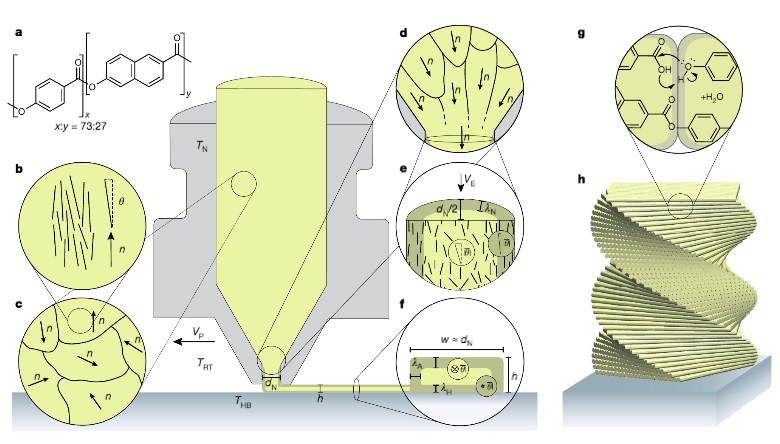Taking inspiration from biological materials such as bone, silk and wood, researchers from the Complex Materials and Soft Materials team at ETH Zurich are 3D printing liquid-crystal-polymer structures.
The resulting structures are both tough and stiff. But, this is not because of the materials they use, but because of complex, hierarchically structured shapes.
The researchers explain that 3D printed parts for aircraft, vehicles and biomedical implants need to be stiff and lightweight. But, the process of 3D printing such parts currently involves using fiber-reinforced polymers which have labor-intensive fabrication processes and are costly to make.
Furthermore, the results are difficult to shape and recycle as well as being brittle and easily fractured. They explain their findings in the journal Nature, saying: “The manufacture of polymer-based lightweight structures is currently limited either to 3D-printed complex parts, which show poor molecular orientation and mechanical strength.”
Meanwhile, biological materials have outstanding mechanical properties. So, the researchers are demonstrating a 3D printing approach to generating structures which are tough, lightweight and recyclable by using hierarchical architectures and complex geometries.

Creating Stiff and Tough Prints Inspired by Nature
The researcher’s complex geometries are 3D printed from liquid-crystal-polymers or a thermotropic liquid crystal polymer (“Vectra A950”) using a fused deposition modelling (FDM) nozzle.
They claim that the resulting prints are comparable with the highest performance lightweight composite materials available.
Liquid-crystal polymer molecules self-assemble into oriented domains during extrusion as a molten feedstock material. The researchers explain how they oriented the molecular domains with the print path.
They explain: “Such a design principle is inspired by the ability of living tissue like bone to deposit mineral phases only along the stress lines developing throughout the structure – during bone growth, for example… This is also known as Wolff’s Law. They add, “The ability to combine the top-down shaping freedom of 3D printing with bottom-up molecular control over polymer orientation opens up the possibility to freely design and realize structures without the typical restrictions of current manufacturing processes.”
Amazingly, the printed laminates demonstrate stiffness and strength which is not far from carbon-fiber reinforced polymers.
As this research was conducted using a commercial desktop 3D printer and a readily available polymer, the researchers hope that others will repeat the research. The next step for the researchers is to use this technique for real-world applications.
Source: Physics World

License: The text of "ETH Zurich Researchers Print Tough Hierarchical Liquid-Crystal-Polymer Structures" by All3DP is licensed under a Creative Commons Attribution 4.0 International License.